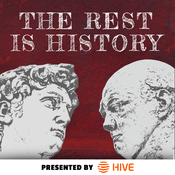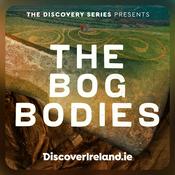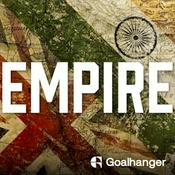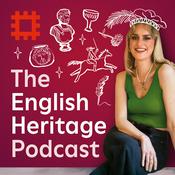24 episodes

EP: 23 The Secret Link between India & Africa with Jijith Nadumuri Ravi
16/11/2025 | 1h 14 mins.
Episode from The Immortal India Podcast with Amish Tripathi & Jijith Nadumuri RaviIn this illuminating episode of The Immortal India Podcast, author Amish Tripathi welcomes Jijith Nadumuri Ravi, a former ISRO space scientist and author of Rivers of Rigveda. Together, they explore a fascinating perspective on human origins and migrations — the idea that while Homo sapiens first evolved in Africa, India became the central cradle for populations outside the continent.What's Inside:Trace the remarkable journey of the early explorers who left Africa, followed coastal routes across now-submerged Arabian and Iranian shores, and established themselves in the Indian subcontinent.Understand the science behind this theory, supported by genetics and insights from the Human Genome Project. About the Guest:Jijith Nadumuri Ravi is a former ISRO scientist and the author of Rivers of Rigveda, which delves into the geo-chronology of the Rigveda and offers a fresh update on the Out of India Theory. His other acclaimed works include Geography of Ramayana and Geography of Mahabharata, where he intricately maps ancient Indian texts to real-world geography.(Amish, Jijith, Africa, India, Human origins, Human Migrations, Human Genome Project) Like, share, and subscribe for more from the Immortal India Podcast.Social media channels:Instagram: @authoramishFacebook: @authoramishX/Twitter: @authoramish#ImmortalIndiaPodcast#AmishTripathi#JijithNadumuriRavi#HumanOrigins#HumanMigration#OutOfAfricaTheory#OutOfIndiaTheory#AncientIndia#IndianCivilization#HumanGenomeProject#GeneticsResearch#Rigveda#RiversOfRigveda#IndianHistory#VedicHistory#Archaeogenetics#Anthropology#SciencePodcast#HistoryPodcast#IndiaAfricaConnections#AncientMigration#ISROScientist#AmishInterviews#IndianKnowledgeSystems

EP: 22 Relationships & Marriages in Ancient India: Amish x Brishti
16/10/2025 | 31 mins.
Relationships & Marriages in Ancient IndiaAmish x Brishti Guha | The Immortal India PodcastWhat did love, marriage, and relationship really mean in ancient India? Were these rigid and conservative institutions, or did they flourish in an environment of freedom, understanding, and mutual respect?In this captivating episode, Amish speaks to our special guest, Dr. Brishti Guha, Associate Professor of Economics at the Centre for International Trade and Development, Jawaharlal Nehru University. Together, they explore the truths about relationships & marriages in India’s past—revealing a society richer and more open-minded than modern preconceptions might suggest.The discussion spans stories of polyandry, such as Draupadi’s marriage to five Pandavas in the Mahabharata, to the encouragement of widow remarriage across ancient texts, including the Rigveda, Arthashastra, and even theMahabharata. These examples show that the understanding of relationships in ancient India could be surprisingly modern, inclusive, and diverse.Dr. Guha tells us about the fascinating range of marriages featured in ancient scriptures:Gandharva Vivaha (marriage by mutual love)Rakshasa Vivaha (marriage by abduction)Pisacha Vivaha (marriage by force)Inter-caste and cross-varna marriagesTraditional arranged marriagesAnd many more—each demonstrating the complexity and inclusiveness of social life in ancient IndiaThrough this thoughtful conversation, the podcast brings to life a world where individual choice, love, and dharma harmonize with duty, family, and respect for personal will.If you are passionate about Indian heritage, culture, and philosophy, this episode will transform the way you view the past—and offer valuable lessons for today.Don’t forget to like, share, and subscribe for more insightful conversations!Find Brishti Guha on Instagram: @brishtiguha12Social media channels of Amish Tripathi:Instagram: @authoramishFacebook: @authoramishX/Twitter: @authoramishReference Links — For Deeper Exploration1. Mahabharata(Adi Parva, Chap 122: Pandu tells Kunti how marriages used to be open until Shvetaketu changed the custom.Adi Parva, Chap 168: Polyandry, Draupadi marries five Pandavas and Yudhishthir mentions other such marriages in older times.Adi Parva, Chap 217: Arjun and Chitrangada's "contract" marriage, Arjun gives up rights to his future children with ChitrangadaUdyog Parva, Chaps 114-117: story of Madhavi and her multiple marriagesA link to an English translation of the Sanskrit Mahabharata online is https://sacred-texts.com/hin/maha/index.htm2. RigVeda (hymn 10.18 is the famous "burial hymn" or "funeral hymn" which talks about widow remarriage). The best translation of the RigVeda is the Jamison and Brereton translation, which also contains a discussion of the word "didhishu" in the hymn, which means "second husband". Here is a link to the Sanskrit hymn:https://sacred-texts.com/hin/rvsan/rv10018.htm3. Arthashastra, Book 3, chapters 2 to 4 talk about widow remarriage and inheritance laws relating to children of women who marry more than once4. Kamasutra, Book 4, chapter 2 also talks about widow remarriage.5. Harita Dharmasutra talks about "sadyovadhus" and "brahmavadinis", the latter usually didn't marry.6. Ashvalayana Grihyasutra gives a list of highly respected teachers and many women (Gargi, Sulabha, Maitreyi, Vadava Pratitheyi) are on the list.7. Baudhayana Dharmasutra, Book 1, chapter 11.20.16 talks about gandharva vivaha being the most popular with everyone.8. Texts with examples of gandharva vivaha include:Avimaraka (of Bhasa), a play where a princess marries a shepherdChaurapanchasika (of Bilhana), written when the poet was caught having a secret relationship with a princessAbhigyana Shakuntalam (of Kalidasa)BrihatkathaDashakumaracharita9. Ancient Indian Historical Tradition by F.E Pargiter explains how there were many mixed castes because intercaste marriages were extremely common.

EP: 21 Mystery Of India's Lost Maritime Empire
25/9/2025 | 48 mins.
In this episode of the Immortal India Podcast, Amish Tripathi is joined by historian and author Nick Collins for an eye-opening exploration of India’s maritime history and its pivotal role in ancient global civilization. Drawing from Nick’s groundbreaking book, "How Maritime Trade and the Indian Subcontinent Shaped the World: Ice Age to Mid-Eighth Century," the discussion uncovers how ancient Indian merchants, thinkers, and adventurers shaped the fortunes of the ancient world.What’s Inside:Learn how India’s influence sailed across seas—spreading innovations, ideas, and philosophy far beyond its borders.Explore how the Indian subcontinent became a central hub of ancient maritime trade, influencing civilizations from Sumeria to Egypt and Greece.Discover evidence and theories about Indian migrants shaping ancient cultures, including the Hittites, Mitannis, Greeks, and Trojans.Delve into the history of Lothal and how its exports shaped interactions with Sumeria, highlighting the dynamic exchange of goods and ideas.About the guest:Nick Collins studied history at Magdalene College, Cambridge, and then embarked on a career in maritime trade with Clarkson, the world’s leading provider of maritime services. His book investigates how Indian trade and philosophy have left an enduring mark on world civilizations, making him an exciting and insightful guest on Immortal India.Social media channels of Amish Tripathi:Instagram: @authoramishFacebook: @authoramishX/Twitter: @authoramish

EP 20: Writers Masterclass with Ashwin, Amish & Akshat
11/9/2025 | 1h 25 mins.
In this episode of Immortal India, Amish Tripathi is joined by bestselling authors Ashwin Sanghi and Akshat Gupta for an insightful conversation on the future of writing for upcoming writers. Together, they explore what truly determines success in the writing world, sharing powerful lessons- why everyone is a storyteller but not every storyteller is a bestseller, and how marketing is a very important element in this journey.The discussion dives into essential writing skills, editing strategies, and the impact of artificial intelligence on creative expression. Packed with practical advice, candid opinions, and personal experiences, this episode is a must-watch for anyone looking to thrive as a writer in today’s dynamic landscape.Like, share, and subscribe for more from the Immortal India Podcast.#ImmortalIndiaPodcast #AmishTripathi #AshwinSanghi #AkshatGupta #WritingTips #StorytellingSocial media channels:Instagram: @authoramishFacebook: @authoramishX/Twitter: @authoramish

EP 19: Gyanvapi : Temple or Mosque | The Harsh Truth Every Indian Must Know | ft. Vikram Sampath
18/8/2025 | 1h
In this episode of Immortal India, Amish Tripathi is joined by historian and author Vikram Sampath for a deep, nuanced conversation on the history of Kashi’s Gyanvapi and the Kashi Vishwanath temple—its antiquity, repeated destruction, and the many attempts at reconstruction across centuries. The discussion also explores themes from Vikram’s latest book, “Waiting for Shiva: Unearthing the Truth of Kashi’s Gyan Vapi,” which traces the site’s layered past and the enduring resilience of devotees and the city of Kashi.What’s inside:The sacred geography of Kashi and the legacy of Vishweshwara/Vishwanath in India’s civilizational memory.Early destructions and rebuilds: from Qutb-ud-din Aibak’s razing in 1194CE to notable reconstructions under Akbar-era nobles like Raja Todar Mal, and later completions under Jahangir’s period.Aurangzeb’s 1669 order, the demolition of the temple, and the mosque constructed on the site—plus how remnants of the old temple persist in the structure.The 18th-century revival nearby under Queen Ahilyabai Holkar and the ongoing civilizational impulse to rebuild and remember.The modern debate and legal-historical discourse surrounding Gyanvapi and what it tells us about India’s culture, law, and identity today.Vikram Sampath on “Waiting for Shiva”: why this story matters now, archival traces, and the blend of history, faith, and memory that shapes public understanding of Kashi.About the Guest:Vikram Sampath is a renowned historian and bestselling author whose works include major biographies and civilizational histories; in “Waiting for Shiva,” he examines the long arc of Kashi’s Gyanvapi—from sacred origins through waves of iconoclasm to the steadfast resilience of its devotees.Follow Amish Tripathi:Instagram: @authoramishFacebook: @authoramishX/Twitter: @authoramish
More History podcasts
Trending History podcasts
About Immortal India with Amish
Listen to Immortal India with Amish, Real Dictators and many other podcasts from around the world with the radio.net app

Get the free radio.net app
- Stations and podcasts to bookmark
- Stream via Wi-Fi or Bluetooth
- Supports Carplay & Android Auto
- Many other app features
Get the free radio.net app
- Stations and podcasts to bookmark
- Stream via Wi-Fi or Bluetooth
- Supports Carplay & Android Auto
- Many other app features


Immortal India with Amish
download the app,
start listening.




































